Alana Barton
Media Technical Advisor

Media Technical Advisor
With current data on more than 200 countries and territories, PRB’s World Population Data Sheet offers essential context for journalists reporting on policy, public services, health, climate, and other critical issues shaped by population shifts. The Data Sheet provides a comprehensive view of where and how populations live, projecting trends in growth, decline, and factors affecting population change. Each year’s special focus takes an in-depth look at a topic like climate adaptation so we can better understand what the data show and why it matters. PRB provides media resources that guide journalists on how to report on these complex topics for their communities.
This media brief on primary health care (PHC), a special focus of the 2024 World Population Data Sheet, identifies the components, actors, and systems of this holistic step toward universal health coverage. It includes definitions and highlights data that can be used to report stories about how PHC touches every part of our society.

Media Technical Advisor
With current data on more than 200 countries and territories, PRB’s World Population Data Sheet offers essential context for journalists reporting on policy, public services, health, climate, and other critical issues shaped by population shifts. The Data Sheet provides a comprehensive view of where and how populations live, projecting trends in growth, decline, and factors affecting population change. Each year’s special focus takes an in-depth look at a topic like climate adaptation so we can better understand what the data show and why it matters. PRB provides media resources that guide journalists on how to report on these complex topics for their communities.
Two media briefs explore climate adaptation and resilience, a special focus of the 2023 World Population Data Sheet. They demystify key concepts and provide journalists with causes, consequences, and examples of this issue.

A library of research on how digital health interventions can engage youth in low- and middle-income countries to minimize their risks of noncommunicable diseases.
AstraZeneca Young Health Programme
NCDs, such as cancer, diabetes, and cardiovascular disease, are the leading causes of death worldwide. Premature deaths from NCDs, defined by the World Health Organization as occurring between ages 30 and 70, take place disproportionately in LMICs and affect individuals at the height of their economic productivity.
NCDs pose a major threat to the health of populations, place an increasing burden on health systems, and threaten economic growth and development. Prevention is therefore a critical priority for addressing the growing NCD epidemic. In addition, the Sustainable Development Goals call for reducing premature mortality from major NCDs by one-third by 2030. Early intervention that focuses on young people is key to reducing premature NCD mortality.
Over 80% of premature deaths from NCDs are due to cardiovascular diseases, cancers, diabetes, and chronic respiratory diseases. These NCDs share four key behavioral risk factors—tobacco use, harmful use of alcohol, physical inactivity, and unhealthy diet—that are all modifiable and typically begin or become habits in adolescence and young adulthood.
Today, there is a unique window of opportunity to curb the NCD epidemic before young people develop unhealthy behaviors and while many LMICs still have relatively young populations. By encouraging young people to adopt positive behaviors and limit negative ones as they gain autonomy over their lives, we can reduce premature deaths from NCDs and set youth on healthier paths into adulthood.
The opportunity to implement digital health interventions in LMICs is increasing as access to the internet expands globally, particularly for young people who access the internet at a higher rate than older age groups. While many digital health interventions addressing the risk behaviors among young people have been tried and evaluated in high-income countries, such interventions have been much less common in LMICs. What’s more, only a few have been evaluated and information about their evaluation is scattered.
The research presented on this site covers a range of digital platforms, including phone apps, text messaging, websites, social media platforms, and online games. Only interventions that specifically targeted young people within the age range of 10 to 24, or those with a study sample predominantly composed of young people were considered for inclusion. Studies were further limited to those that had samples large enough to assess the effectiveness of the interventions, and most were published in 2015 or later.
Many of the studies suffered from limitations, including small sample sizes, high attrition rates, short trial periods, and reliance on self-reporting, and very few were grounded in theoretical behavior change. Nevertheless, our summaries highlight a variety of efforts to use digital platforms to address NCD risk behaviors in youth, some of which have shown promising results, and help build a knowledge base for anyone working to develop, revise, or better understand such interventions to improve health outcomes and to reduce the growing NCD epidemic.

Research Technical Assistance Center
The Amazon rainforest, including its river network, is rapidly approaching a critical point at which more than half of its ecosystems will be permanently and drastically altered. Preventing or slowing this process requires action to preserve the rainforest and ecosystems that exist today, especially those that have been less altered by development.
The Amazon Rainforest is an essential global resource, but existing dams harm river ecosystems, threaten the wellbeing of indigenous people and local communities and endanger the cultural heritage of Brazilian riverine communities. This fact sheet outlines steps that global and national partners can take to preserve Amazonian rivers.
The information presented in this policy brief is based on the research project “Linking Sustainability of Small-Scale Fisheries, Fishers’ Knowledge, Conservation, and Co-Management of Biodiversity in Large Rivers of the Brazilian Amazon,” led by Dr. Renato Silvano of Universidade Federal do Rio Grande do Sul with Dr. Gustavo Hallwass at Universidade Federal de Lavras.
Research Technical Assistance Center
This innovation brief describes the growing impact of hydroelectric dams on the Amazon River ecosystem in Brazil, including changes to landscapes, wildlife diversity and food security for local communities. It offers recommendations for improving existing policy instruments to ensure that assessments for new dams in the basin include flooded environments and impacts on the broader ecosystem.

(April 2012) For some time now, Brazil, Russia, India, and China have been grouped together under the acronym BRIC. The BRICs are described as countries at the same stage of economic development, but not yet at the point where they would be considered more developed countries. The BRIC position argues that, since the four countries are “developing rapidly,” their combined economies could eclipse the collective economies of the current richest countries of the world by 2050.
The combined 2010 gross national income of the BRICs was US$10.5 billion, 25 percent of the GNI of high-income countries (see table). In 2009, it was 15 percent of the world total. The BRICs rank quite high in terms of global GNIs and China has almost certainly overtaken Japan by now to claim the second spot.
Brazil, Russia, India, and China, Selected Indicators
| Indicator | Brazil | Russia | India | China |
|---|---|---|---|---|
| Population mid-2011 (millions) | 197 | 143 | 1,241 | 1,346 |
| Population 2050 (millions) | 223 | 126 | 1,692 | 1,313 |
| Percent of population <age 15 | 25 | 15 | 33 | 17 |
| Total fertility rate | 1.9 | 1.6 | 2.6 | 1.5 |
| Percent of population living <$US2/day | 10 | 1 | 76 | 36 |
| 2010 gross national income (in billions)* | $1,830 | $1,404 | $1,554 | $5,721 |
| 2010 world rank for GNI | 8 | 12 | 11 | 3 |
| 2010 gross national income per capita* | $9,390 | $9,910 | $1,340 | $4,260 |
| GNI growth rate (%), 2009-2010 | 15.8 | 6.3 | 10.1 | 17.1 |
* Atlas method.
Sources: Population Reference Bureau; United Nations Population Division; International Labour Organisation; National Statistical Offices; and World Bank.
The picture changes dramatically when we consider the countries’ rank on GNI per capita. The size of their economies is largely a result of population size.The BRICs are among the top 10 countries in the world in population.
Will the BRIC economies really eclipse the world’s wealthier countries? Table 1 offers one way to quantify that possibility. The high GNI growth rates of China and India are partly due to the still relatively small size of their economies. As economies grow, we can expect rates of growth to decrease simply because the denominator, GNI, will grow. Let’s assume that the BRICs will average a 4 percent GNI growth rate for the next 40 years and the high-income countries will average 2 percent. That latter assumption, of course, posits that the current recession will end at some point. And, an assumption of 4 percent growth for the BRICs over such a long period is rather generous. Under that scenario, the combined income of the BRICs would rise from 25 percent of the high-income countries’GNI in 2009 to 49 percent in 2050. Not exactly an eclipse but significant growth nonetheless.
Age is all-important for its effect on the size of the labor force. India remains a rather young country with 33 percent of its population below age 15. Brazil is not far behind at 25 percent, while China and Russia, due to their very low birth rates, have only 17 and 15 percent, respectively.
The population pyramids (age and sex structure) of all four BRIC countries are quite different, primarily a result of their different birth histories. Brazil and China are somewhat similar, reflecting their transition to low birth rates. Brazil’s total fertility rate (the average number of children per woman) is now at a low, industrialized-country level of 1.9 children per woman. India has also made considerable progress in its fertility transition, but its TFR is still about 2.6.
Age and Sex Structure of Brazil (2010) and Russia (2010)
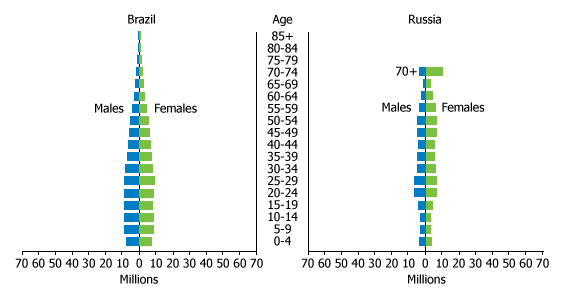
Sources: Brazil: United Nations; Russia: GOSKOMSTAT.
Age and Sex Structure of China (2010) and India (2011)
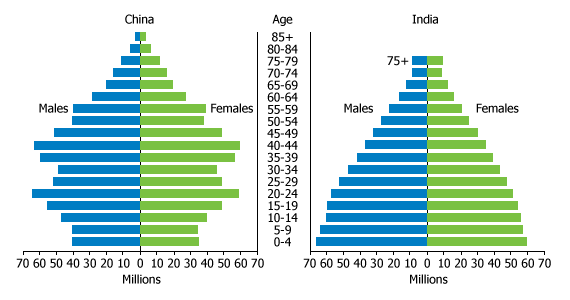
Sources: China: IDB; India: PRB/PFI projections.
China and Russia present two unusual age structures. China’s jagged pyramid results from a number of factors: mass deaths, social disruption, and the country’s “one-child” policy, all of which affected the population structure. In Russia, the economic disruption following the breakup of the USSR dropped the TFR below 1.2 in 1999, although it had risen to nearly 1.6 by 2010 (a rise that slowed in 2011). India is the “youngest” country of the group, and even by 2050, the 0-4 age group will be virtually equal to the 5-9 group.
Both China and India still have substantial proportions of their labor force engaged in agriculture, but in India the proportion is a whopping two-thirds. In India, only about 7 million people work in the “organized” manufacturing sector (factories that register with the government and, supposedly, maintain records and pay workers required benefits). These workers, however, account for about two-thirds of manufacturing output while earning a comparatively high wage equivalent to US91 cents per hour in 2006.1 The great majority of India’s labor force of 400 million work in the unorganized sector, where work varies from casual day labor to work in small shops and fabrication facilities and for which comparable labor force data are not available.
The large proportion of the population living in poverty—abject poverty—is often overlooked. The World Bank estimates that 76 percent of the population in India lives on less than US$2 per day, compared to 36 percent in China. Over 900 million people living in poverty in India, most with little effective education, are not likely to share in the prosperity enjoyed by a few and are not likely to form the basis for an exploding consumer market anytime soon. China’s future is difficult to foresee in that it now faces unaccustomed population aging should it not relax its stringent one-child policy. But China, unlike India, is one of the world’s largest exporters.
Of the four BRIC countries, Russia seems a true outlier. Despite an uptick in the birth rate, it still had 130,000 more deaths than births in 2011, primarily due to a decrease of 106,000 deaths in 2011 from the 2010 level. It had reported nearly 1 million more deaths than births in 2000. Childbearing among women ages 20 to 29 and the number of women moving into those ages will diminish sharply over the next 20 years, even with some offsetting effects of immigration.
Several things need to happen for the BRICs to reach their advertised potential. In India, a massive campaign to provide potential workers with education and training will be required. The government is trying to tackle this daunting task but provincial politics can be a major obstacle. As an official from the impoverished state of Bihar once commented to me regarding the demographic dividend in his state, “Having a huge amount of illiterate people is not an advantage!” Relaxed regulations in the early 1990s for foreign investments jump-started the Indian economy. Will China follow? China has a clearly disadvantageous demographic profile, and may need to alter it through immigration or by allowing the birth rate to rise? At the very least, Russia will likely have to rely on immigration to fill its labor force gaps. Finally, Brazil does have the appearance of a country whose economy has reached an advanced stage with a high per capita GNI. That said, the current world economic situation can too easily reshape the very different societies of the BRICs.
Carl Haub is a senior demographer at the Population Reference Bureau.

February 8, 2012
(February 2012) Sprawling urban areas most obviously demonstrate the environmental impact of migration. Water scarcity, pollution, and lack of adequate housing are some of the more evident impacts of urban population growth. But migration also affects the environment of the communities from which the migrants come, and may actually protect forests. Recent research in the journal Population and Environment suggests that migrant remittances (earnings sent home) often shape household decisionmaking about land use at forest edges.
Migrant remittances have become a powerful social and economic force. According to the World Bank, remittances are expected to total over $350 billion in 2011, representing three times the size of official development assistance.1 Hans Timmer, director of the Bank’s Development Prospects Group, explains, “Despite the global economic crisis that has impacted private capital flows, remittance flows to developing countries have remained resilient, posting an estimated growth of 8 percent in 2011.”
As households in developing nations seek to diversify income sources and minimize risk, migration represents a common economic strategy—remittances often are essential to meet household needs. Less obvious, however, are the environmental implications of remittances. And these environmental effects are not commonly discussed within policy circles, perhaps because research on the remittance-land use connection is only beginning to yield an overarching story. New research clearly suggests that remittances are reshaping the ways in which agricultural households manage their local environments and land holdings.
Clark Gray, a researcher at the University of North Carolina at Chapel Hill, has undertaken extensive fieldwork in Ecuador to examine these associations. Migration is a prominent livelihood strategy in Ecuador. Since 1990, over 1 million Ecuadorians have emigrated, and international remittances represented 6.4 percent of the nation’s 2005 GDP.
In Gray’s study area of southern Loja province, households depend mostly on maize-centered small-farm agriculture, small-scale cattle ranching, and coffee-based agroforestry which allows for shade coffee production under the forest canopy. Still, the region’s agricultural productivity is marginal, suggesting that out-migration provides better options for income. Although out-migration might be linked with declining agricultural production (due to loss of farm labor), Gray found otherwise based on a survey of approximately 400 rural households. International migrant remittances are more often used to increase farm production through hired labor as well as through enhanced fertilizer use. In fact, “a doubling of international remittances led to a 7.4 percent increase in spending on chemical inputs,” explains Gray.2 In this setting, migrant remittances can intensify agricultural production on existing land and reduce pressure to expand cropland into forests.
Other research on the remittance-land use connection has been undertaken in the Brazilian Amazon. Leah VanWey, a Brown University researcher, has studied land use decisionmaking among Amazonian households for decades. Her work has primarily focused on small-farm families in Altamira, Para, Brazil, initially settled in the 1970s as a result of the TransAmazon highway.3
Agricultural-based livelihood strategies characterize this region. Households plant subsistence annual food crops—manioc, beans, and rice— mostly for personal consumption. Other strategies include raising cattle for regional markets, although many years are required to create pasture from forest. Perennial cash crops, especially cacao, are also common. These cash crops, destined for international markets have the highest income return, but substantial savings or access to credit are needed to purchase sufficient seedlings. Cacao also has a long maturation time—often 10 years to peak production.
Migrants from the region tend to come from households with plentiful labor, so the loss in farm help doesn’t typically reduce agricultural production. Instead, migrant remittances encourage investment in capital-intensive perennial production, mostly cacao, in place of clearing forest for pasture (see figure). VanWey and her collaborators conclude that providing migrant income opportunities and promoting capital-intensive crops where possible “has the potential to protect forest and improve rural livelihoods.”
Property in Perennials and Pasture, by Migrants Sending Remittances
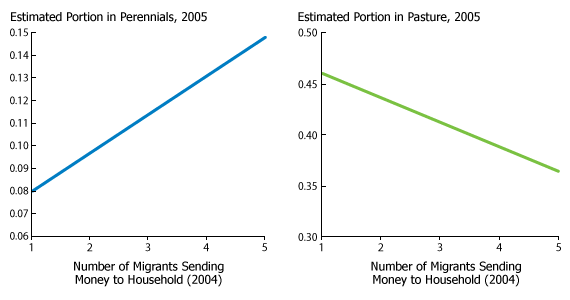
Source: Adapted from Leah K. VanWey, Gilvan R. Guedes, and Alvaro O. D’Antona, “Out-Migration and Land-Use Change in Agricultural Frontiers: Insights From the Altamira Settlement Project,” Population and Environment (online, Dec. 6, 2011).
A slightly different dynamic plays out in the highlands of Guatemala. Based on ethnographic case studies in two rural communities, University of California-Santa Barbara researchers Jason Davis and David Lopez-Carr find that remittances are primarily used for new home construction and educational expenses, although hiring agricultural labor and using fertilizers are also common. In fact, although overall levels of household consumption may rise, agriculturally productive areas may actually shrink because aging parents tend to use the remittances to purchase food as a substitute for on-farm food production.4
Still, the protection or regrowth of local forest may come with a cultural cost. Scholars James P. Robson and Prateep K. Nayak argue that migration can “facilitate deep-seated change in traditional ways of life, whereby migrants (and their families) become disconnected from both resource practices and the institutions of the home (or sending) community.”5 In their rural Mexican study site, migration is associated with a decline in subsistence agriculture and an increased dependence on the marketplace for food and other necessities. In fact, their research suggests that between 50 percent and 60 percent of traditional agricultural lands have been abandoned over the past 30 to 40 years. Although such abandonment means forest regrowth, the researchers lament the loss of community and traditional natural resource management institutions.6
In absolute numbers, international migration is at an all-time high. And remittances to developing countries are expected to continue increasing at a rate of 7 percent to 8 percent annually, potentially reaching $441 billion by 2014. Although migration’s impacts may be most obvious in migrant destinations, these remittances alter socioeconomic and environmental patterns and processes in origin areas as well, but may help protect forests.7
Lori Hunter is an associate professor of sociology, Institute of Behavioral Science, Programs on Population, Environment and Society, at the University of Colorado, Boulder. She is also editor-in-chief of Population and Environment. This article is part of PRB’s CPIPR project, funded by a grant from the Eunice Kennedy Shriver National Institute of Child Health and Human Development. Hunter is liaison from the University of Colorado’s Population Center to CPIPR. Other NICHD-funded researchers who are highlighted in this article are Clark Gray, University of North Carolina, Chapel Hill; and Leah VanWey, Brown University.

May 20, 2011
Half of men ages 18 to 70 who participated in a study of genital human papillomavirus (HPV) in Brazil, Mexico, and the United States were infected with some form of the virus, according to the “HPV in Men” (HIM) study recently published in The Lancet.1 Anna Giuliano, of the H. Lee Moffitt Cancer Center, and her colleagues screened 4,074 men from the general population, universities, and organized health care systems in southern Florida; Sao Paulo, Brazil; and Cuernavaca, Mexico. The researchers studied the natural history of HPV infections to get a snapshot of how they affect men.
HPV is a group of more than 150 types of related viruses—of which more than 40 are sexually transmitted and can be spread very easily through genital contact with another person.2 Genital HPV is the most common sexually transmitted infection in the United States, currently affecting about 20 million Americans.3 According to the U.S. Centers for Disease Control and Prevention, HPV is so common that at least half of sexually active men and women get it at some point in their lives. But only one type, HPV-16, causes cancer in men, said Giuliano in an interview with NPR on March 4, 2011.4
Giuliano’s study reports on the first 1,159 men who participated in the study. At the time of enrollment, 50 percent of men were infected with genital HPV. “We were actually detecting 37 different types of HPV occurring—that could occur in men at the external genital skin. And we followed men prospectively so we could actually look at the rate at which men acquire these new infections, and the rate at which these infections are cleared,” she told NPR. She emphasized in the interview that the study was “a summary measure of all HPV types that were detected”—only some of the 37 HPV types cause cancer.
Some genital HPVs are high-risk, causing cancer and other diseases; others are low-risk, for example, those causing genital warts.5 About 15 high-risk viruses are factors in cancer of the cervix, vulva, vagina, anus, and head and neck in women; and contributors to cancers of the penis, anus, and head and neck in men (see Table 1). HPV infection accounts for 5 percent of all cancers worldwide. HPV-16 and HPV-18 together are linked to about 70 percent of cervical cancers. There is no simple screening to find HPV in men and no effective screening for noncervical cancers in men and women.6
Table 1
HPV-Related Cancer and Disease in the U.S.
| HPV-Type Most Attributed | Average Number of Men Affected Yearly | Average Number of Women Affected Yearly | |
|---|---|---|---|
| Anal Cancer | 16 | 1,100 (2010) | 2,700 (2009) |
| Cervical Cancer | 16 & 18 | n/a | 11,000 (2011) |
| Genital Warts | 6,11 | 1 in 100* (2011) | 1 in 100* (2011) |
| Head and Neck Cancers | 16 | 5,700 (2010) | 2,300 (2009) |
| Penile Cancer | 16 | 800 (2010) | n/a |
| Vaginal Cancer | 16 & 18 | n/a | 1,000 (2009) |
| Vulvar Cancer | 16 & 18 | n/a | 3,700 (2009) |
Note: *Of sexually active adults.
Sources: Centers for Disease Control (CDC), Genital HPV Infection Fact Sheet, Nov. 24, 2009, accessed at www.cdc.gov, on March 8, 2011; CDC, HPV and Men Fact Sheet, October 14, 2010, accessed at www.cdc.gov, on March 8, 2011; CDC, “HPV Vaccine: Questions and Answers” (April 6, 2011), accessed at www.cdc.gov/vaccines/vpd-vac/hpv/vac-faqs.htm, on May 16, 2011; Gypsyamber D’Souza et al., “Case-Control Study of Human Papillomavirus and Oropharyngeal Cancer,” The New England Journal of Medicine, May 10, 2007, accessed at www.nejm.org, on March 16, 2011; Maura L. Gillison, Anil K. Chaturvedi, and Douglas R. Lowy, “HPV Prophylactic Vaccines and the Potential Prevention of Noncervical Cancers in Both Men and Women,” Supplement to Cancer, Nov. 3, 2008, accessed at www.interscience.wiley.com, on March 18, 2011; Anna R. Giuliano et al., “Incidence and Clearance of Genital Human Papillomavirus Infection in Men (HIM): A Cohort Study,” The Lancet, March 1, 2011, accessed at www.thelancet.com, on March 7, 2011; and National Cancer Institute, Human Papillomaviruses and Cancer Fact Sheet, Dec. 13, 2010, accessed at www.cancer.gov, on March 14, 2011.
HPV is a silent infection. Most people infected with HPV show no symptoms and can unknowingly transmit the virus to their sexual partners.7 In 90 percent of cases, the body’s immune system clears the infection on its own within two years. In the HIM study group, new HPV infections took an average of 7.5 months to clear (see Table 2). Men ages 18 to 30 require significantly longer than other age groups to clear any type of HPV infection—a phenomenon strongly associated with sexual behavior with female and male sexual partners. While women’s risk of HPV decreases with age, men appear to be at high risk of acquiring new HPV infections throughout their lives.
Table 2
HPV Infection in Men Ages 18-70, 2009
| % Prevalence | |
|---|---|
| Any HPV | 50 |
| Cancer-causing | 30 |
| HPV-16 | 6 |
| HPV-18 | 2 |
| Other | 38 |
| HPV-6 | 7 |
| HPV-11 | 1 |
Source: Anna R. Giuliano et al., “Incidence and Clearance of Genital Human Papillomavirus Infection in Men (HIM): A Cohort Study,” The Lancet, March 1, 2011, accessed at http://www.thelancet.com, on March 7, 2011.
As with other sexually transmitted infections, the risk of getting or transmitting an HPV infection can be significantly reduced by always using a condom. In 2006, the FDA approved vaccines to protect girls and young women from being infected with common types of HPV. Gardasil and Cervarix protect against cancer-causing types 16 and 18, while Gardasil also protects against types 6 and 11 which cause genital warts. These vaccines lessen the risk of new infections; they do not cure existing ones.
While Gardasil has also been approved for boys and men ages 9 through 26, the vaccine is not on the CDC’s recommended immunization schedule for males in this age group. The reason: Studies suggest that the best way to prevent the most HPV-related disease is by vaccinating as many girls and women as possible.8 As of 2009, 17 percent of women ages 19 to 26 had received at least one dose of HPV vaccination. Among boys ages 11 to 17, less than 1 percent have been vaccinated, but the share of vaccinated men on college campuses is around 15 percent.9
While genital warts are not a health threat and do not lead to cancer, Dr. James C. Turner, a liaison to the government’s Advisory Committee on Immunization Practices, indicates that they are more than just a nuisance for those affected: “I would say that the men that I see would rate genital warts on the quality scale just above death,” Turner noted in a New York Times article.10

April 30, 2010
(April 2010) Paraguay does not seem a likely candidate for rapid fertility decline: The population is poorer, more rural, and has lower educational levels than its neighboring countries. A large percentage of the population speaks Guarani, an indigenous language, rather than Spanish, the official language. Yet despite a large population that is traditionally hard to reach with reproductive health information and services, Paraguay recorded a remarkable increase in contraceptive use and a sharp decline in fertility over the past decade. A recent study of Paraguay’s fertility transition through 2004 documented a fall in the total fertility rate (TFR), or lifetime number of births per woman, from 4.3 in 1998 to 2.9 in the 2001-2004 period, and suggested continued decline because younger women said they wanted fewer children.1 A new survey seems to confirm that assertion, showing the TFR down to 2.5 children per woman by 2008, a faster decline than projected in the most recent United Nations’ population projection series.2 The percentage of married women ages 15 to 44 using contraception increased impressively, from 57 percent to 79 percent between 1998 and 2008.
There is a wide gap in TFRs between the more modern and educated populations and the more traditional population groups. The TFR was down to 2.2 children per woman among urban residents, while it was still 3.0 among rural residents in 2002. Similarly, Spanish-speaking women averaged just 2.2 children, compared with 3.3 among Guarani-speaking Paraguayans. The most dramatic differences were by education: Women with less than five years of education averaged 3.6 children, while those with at least 12 years of education averaged just 2.0 children.
Like many developing countries, Paraguay has seen rapid improvements in the education of girls in recent decades. Enrollment in elementary school is nearly universal, and data from UNESCO show the percentage enrolled in secondary school rising from 59 percent to 68 percent between 1999 and 2002, the most recent year statistics are available. This is well below the regional average of 92 percent, but a marked improvement in just a few years.3
Recent increases in the education of women in Paraguay have been tied to greater contraceptive use up through 2004. However, the 2008 survey shows that acceptance of contraceptive use has spread among all education levels. Even among women with less than three years of formal education, 72 percent used a contraceptive in 2008, compared with just 36 percent in 1998 (see Figure 1). Just as telling, the gap in contraceptive use between urban and rural women disappeared by 2008. While there are still clear rural and education differences in actual childbearing, it seems likely that those differences will abate further in coming years.
Figure 1
Increasing Contraceptive Use Among Paraguayan Women, 1998 to 2008
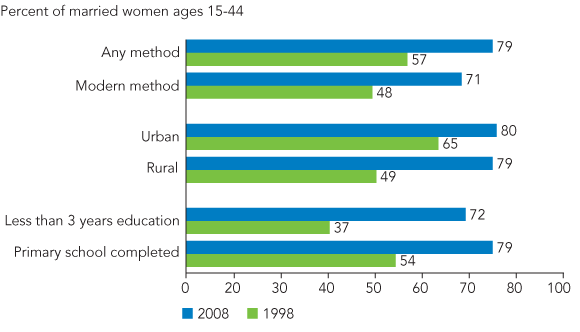
Source: El Centro Paraguayo de Estudios de Población et al., Paraguay Reproductive Health Survey 2008, CD-ROM.
With the low and declining fertility documented in these new surveys, Paraguay joins its more urbanized and prosperous neighbors in South America’s southern cone in forming a low-fertility zone.
Brazil saw impressive declines in fertility since the mid-1990s, from about 2.5 children per woman to 1.8 according to the National Institute for Geography and Statistics (IBGE)—possibly the lowest in South America. Brazil’s fertility decline has been attributed to a shift in preferences for fewer children that some analysts tie to popular nighttime soap operas, or telenovelas, that reinforced the positive image of small families.4 Effective contraceptives are widely available, with sterilization (male and female combined) the most common method.5
Argentina has had relatively low fertility—below 3 children per couple—for decades, but the TFR only recently dropped close to the replacement level of 2.1 children per women (see Figure 2). Fertility has tracked even lower in Uruguay and Chile. Uruguay’s TFR is now at the two-child level, according to official birth statistics. Chile’s fertility declined close to replacement level by 2000, and is now about 1.9. While we do not have recent surveys of contraceptive use from these other countries, there is evidence that contraceptives are widely available and accepted.
Figure 2
Fertility Decline in Southern Cone Countries, 1990-95 to 2010
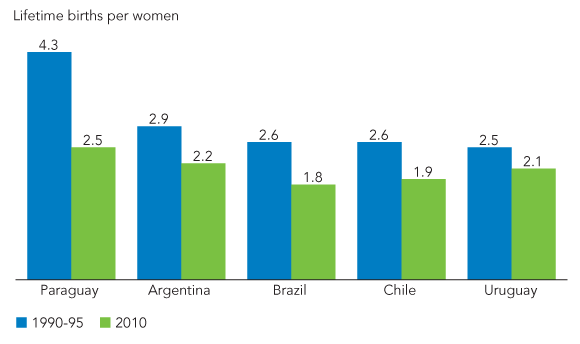
Sources: UN Population Division, World Population Prospects: The 2008 Revision; UN Statistics Division, UN Demographic Yearbook, 2006; Ministério da Saúde e Centro Brasileiro de Análise e Planejamento, Pesquisa Nacional de Demographfia e Saúde da Criança e da Mulher, 2006; El Centro Paraguayo de Estudios de Población et al., Paraguay Reproductive Health Survey 2008, CD-ROM.
While fertility rates have fallen throughout South America, they have not fallen as far in the more northern countries, especially in Bolivia, Ecuador, and Peru. Bolivia has among the region’s highest fertility, with a TFR of 3.5 according to a 2008 Demographic and Health Survey. Bolivia, with its large indigenous, non-Spanish speaking population, has the characteristics of a high-fertility country: lower educational levels, high poverty levels, a large rural population, and low use of modern contraceptives. The UN Population Division and the Center for Latin American and Caribbean Demography (CELADE) project modest fertility decline in Bolivia in the next two decades.
Fertility is expected to fall more rapidly in more economically developed and more urban countries of South America, including Colombia and Venezuela. They are projected to join the southern cone countries with replacement level fertility over the next decade. The major uncertainty is how fast fertility will fall, especially in areas that have lagged behind in economic and social development. The surprisingly rapid fertility decline in Paraguay shows how quickly things can change when young couples embrace the idea of smaller families and actively limit the number of children they have.
Mary Mederios Kent is senior demographic editor at the Population Reference Bureau.

(February 2009) Recent population estimates from Brazil’s national statistical office (IBGE) peg the national fertility rate at just 1.9 lifetime children per woman in 2007, lower than previous rates estimated by the UN, the U.S. Census Bureau, PRB, and other international organizations that estimate population measures. Notably, this new estimate is below the long-term replacement fertility rate of 2.1 children per woman—and below the 2.1 estimated for the United States in 2007.
Brazil does not have complete registration of births and has not had a national demographic and health survey since 1996, the usual data sources for national fertility estimates. But IBGE analyzed 2000 Census data, vital registration statistics, and household surveys and found evidence of a sharp fertility decline. These new estimates show the rate falling from 5.3 children per woman in 1970 to 2.8 in 1990, and a projected 1.8 by 2010. The rate levels off at 1.5 children per woman by 2030.
This sharp fertility decline in Latin America’s largest country has major implications for the region’s future population size, and signals significant population aging. Brazil’s population, nearly 190 million in 2008 in the new IBGE estimates, is projected to reach 216.4 million by 2030, and then slip to 215.3 million by 2050. While the total population is projected to decline slightly between 2030 and 2050, for example, the number of Brazilians ages 65 or older is expected to grow by 70 percent.
Mary Mederios Kent is senior demographic editor at the Population Reference Bureau.
References
Instituto Brasileiro de Geografia e Estatística (IBGE), Projeção da População do Brasil por Sexo e Idade—1980-2050: Revisão 2008 (2008), accessed online at www.ibge.gov.br/home/estatistica/populacao/projecao_da_populacao/2008/projecao.pdf, on Feb. 12, 2009.
IBGE, Projeção da População do Brasil: População Brasileira Envelhece em Ritmo Acelerado (Comunicação Social, Nov. 27, 2008), accessed online at www.ibge.gov.br, on Feb. 17, 2009.
UN Population Division, World Population Prospects: The 2006 Revision, Online Data, accessed online on Feb. 12, 2009; and UN Population Division, Worl Population Prospects: The 2008 Revision (forthcoming).
